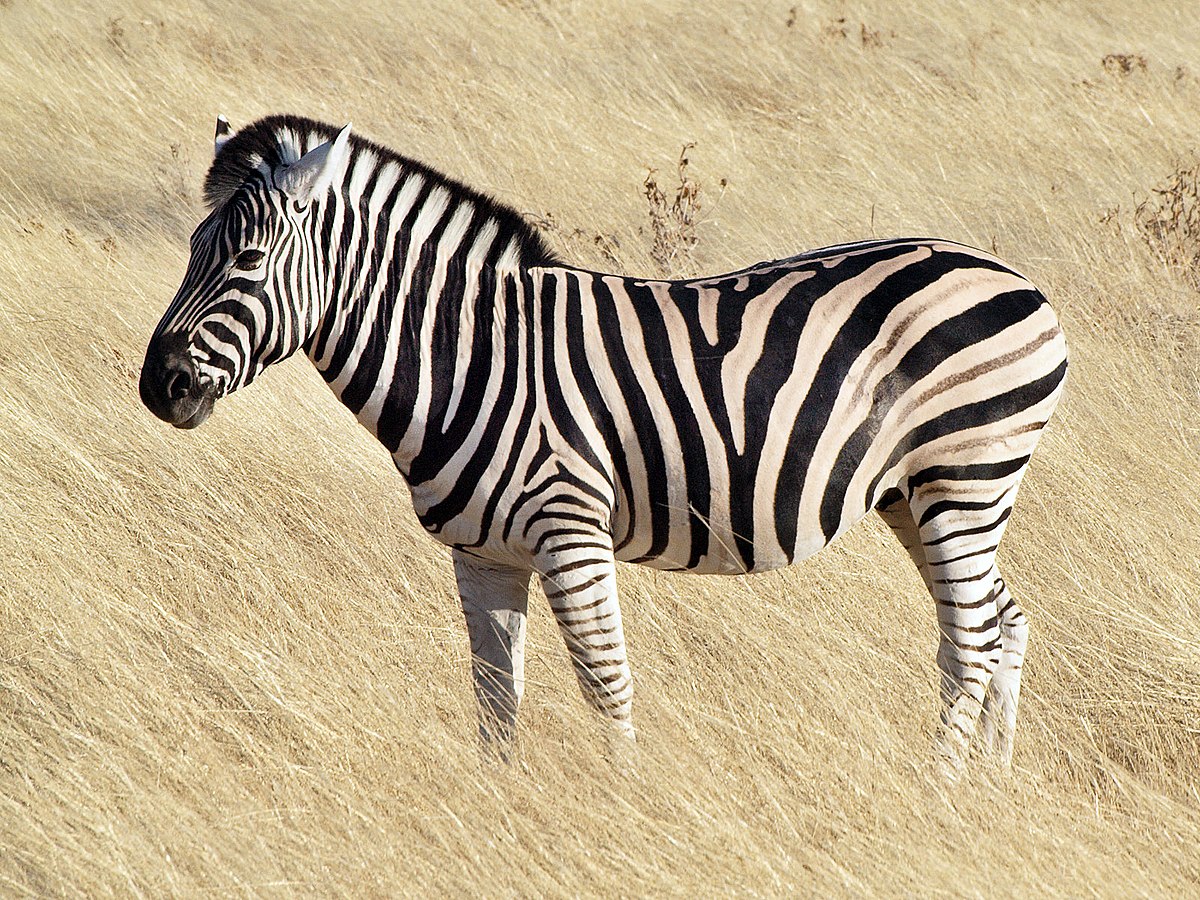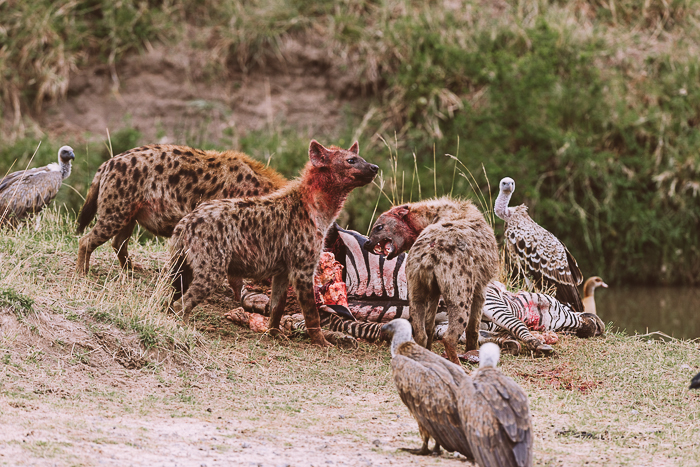Post by rock on May 16, 2019 17:11:06 GMT 5
zebra
home to three different species of zebra, the plains zebra, Grevy’s zebra and mountain zebra, all three species are native to Africa.
The most common species is the plains zebra, which roams grasslands and woodland of eastern and southern Africa. The Grevy’s zebra can be found in dry, semi-desert areas of Kenya and Ethiopia, and the mountain zebra lives in mountainous and hilly habitats in Namibia, Angola and South Africa.
Closely related to horses, zebras have thick bodies, thin legs, a tufted tail, and a long head and neck sporting a short mane. And their most famous feature? Their brilliant black-and-white striped coat, of course!
So why do zebras have stripes? Well, scientists aren’t entirely sure. Their stripes perhaps serve to dazzle and confuse predators and biting insects, or to control the animal’s body heat. Because each individual’s stripes are unique, their stripes may also have a social purpose, helping zebras to recognise one other.
These cool creatures are herbivores and spend most of their day eating grass, and sometimes leaves, shrubs twigs and bark, too. Their teeth are well adapted for grazing, with sharp incisors at the front of their mouth to bite the grass, and large molars at the back for crushing and grinding.
zebras are constantly on the move for fresh grass to eat and water to drink. Super stealthy creatures, they’ll travel thousands of kilometres in search of green pastures where they can fill their bellies and quench their thirst!
zebras are social animals and live together in large groups, called herds. As they migrate to new feeding grounds, ‘super herds’ may form consisting of thousands of individuals. They may team up with other grazers on their travels, too, such as antelope and wildebeest.
Within a herd, zebras tend to stay together in smaller family groups, made up of a dominant male, several females (called ‘mares’) and their young (called ‘foals’). When they are between one and three years old, males (or ‘stallions’) leave to join ‘bachelor herds’ (all-male groups), where they stay until they’re old enough and strong enough to compete for females.

Spotted Hyena - Crocuta crocuta
The spotted hyena (Crocuta crocuta), also known as the laughing hyena or tiger wolf, is a species of hyena native to Sub-Saharan Africa. It is listed as Least Concern by the IUCN on account of its widespread range and large numbers estimated at 10,000 individuals. The species is however experiencing declines outside of protected areas due to habitat loss and poaching. The species may have originated in Asia, and once ranged throughout Europe for at least one million years until the end of the Late Pleistocene. The spotted hyena is the largest member of the Hyaenidae, and is further physically distinguished from other species by its vaguely bear-like build, its rounded ears, its less prominent mane, its spotted pelt, its more dual purposed dentition, its fewer nipples and the presence of a pseudo-penis in the female. It is the only mammalian species to lack an external vaginal opening. The spotted hyena is the most social of the Carnivora in that it has the largest group sizes and most complex social behaviours. Its social organisation is unlike that of any other Carnivore, bearing closer resemblance to that of cercopithecine primates (baboons and macaques) with respect to group-size, hierarchical structure, and frequency of social interaction among both kin and unrelated group-mates. However, the social system of the spotted hyena is openly competitive rather than cooperative, with access to kills, mating opportunities and the time of dispersal for males depending on the ability to dominate other clan-members. Females provide only for their own cubs rather than assist each other, and males display no paternal care. Spotted hyena society is matriarchal; females are larger than males, and dominate them. The spotted hyena is a highly successful animal, being the most common large carnivore in Africa. Its success is due in part to its adaptability and opportunism; it is both an efficient hunter and a scavenger, with the capacity to eat and digest skin, bone and other animal waste. In functional terms, the spotted hyena makes the most efficient use of animal matter of all African carnivores. The spotted hyena displays greater plasticity in its hunting and foraging behaviour than other African carnivores; it hunts alone, in small parties of 2-5 individuals or in large groups. During a hunt, spotted hyenas often run through ungulate herds in order to select an individual to attack. Once selected, their prey is chased over long distance, often several kilmoetres, at speeds of up to 60 km/h. The spotted hyena is the largest extant member of the Hyaenidae. Adults measure 95.0—165.8 cm in body length, and have a shoulder height of 70.0-91.5 cm. Adult male spotted hyenas in the Serengeti weigh 40.5—55.0 kg (89—121 lb), while females weigh 44.5—63.9 kg (98—141 lb). Spotted hyenas in Zambia tend to be heavier, with males weighing on average 67.6 kg (149 lb), and females 69.2 kg (153 lb). Exceptionally large weights of 81.7 kg (180 lb) and 86 kg (190 lb) are known.

home to three different species of zebra, the plains zebra, Grevy’s zebra and mountain zebra, all three species are native to Africa.
The most common species is the plains zebra, which roams grasslands and woodland of eastern and southern Africa. The Grevy’s zebra can be found in dry, semi-desert areas of Kenya and Ethiopia, and the mountain zebra lives in mountainous and hilly habitats in Namibia, Angola and South Africa.
Closely related to horses, zebras have thick bodies, thin legs, a tufted tail, and a long head and neck sporting a short mane. And their most famous feature? Their brilliant black-and-white striped coat, of course!
So why do zebras have stripes? Well, scientists aren’t entirely sure. Their stripes perhaps serve to dazzle and confuse predators and biting insects, or to control the animal’s body heat. Because each individual’s stripes are unique, their stripes may also have a social purpose, helping zebras to recognise one other.
These cool creatures are herbivores and spend most of their day eating grass, and sometimes leaves, shrubs twigs and bark, too. Their teeth are well adapted for grazing, with sharp incisors at the front of their mouth to bite the grass, and large molars at the back for crushing and grinding.
zebras are constantly on the move for fresh grass to eat and water to drink. Super stealthy creatures, they’ll travel thousands of kilometres in search of green pastures where they can fill their bellies and quench their thirst!
zebras are social animals and live together in large groups, called herds. As they migrate to new feeding grounds, ‘super herds’ may form consisting of thousands of individuals. They may team up with other grazers on their travels, too, such as antelope and wildebeest.
Within a herd, zebras tend to stay together in smaller family groups, made up of a dominant male, several females (called ‘mares’) and their young (called ‘foals’). When they are between one and three years old, males (or ‘stallions’) leave to join ‘bachelor herds’ (all-male groups), where they stay until they’re old enough and strong enough to compete for females.

Spotted Hyena - Crocuta crocuta
The spotted hyena (Crocuta crocuta), also known as the laughing hyena or tiger wolf, is a species of hyena native to Sub-Saharan Africa. It is listed as Least Concern by the IUCN on account of its widespread range and large numbers estimated at 10,000 individuals. The species is however experiencing declines outside of protected areas due to habitat loss and poaching. The species may have originated in Asia, and once ranged throughout Europe for at least one million years until the end of the Late Pleistocene. The spotted hyena is the largest member of the Hyaenidae, and is further physically distinguished from other species by its vaguely bear-like build, its rounded ears, its less prominent mane, its spotted pelt, its more dual purposed dentition, its fewer nipples and the presence of a pseudo-penis in the female. It is the only mammalian species to lack an external vaginal opening. The spotted hyena is the most social of the Carnivora in that it has the largest group sizes and most complex social behaviours. Its social organisation is unlike that of any other Carnivore, bearing closer resemblance to that of cercopithecine primates (baboons and macaques) with respect to group-size, hierarchical structure, and frequency of social interaction among both kin and unrelated group-mates. However, the social system of the spotted hyena is openly competitive rather than cooperative, with access to kills, mating opportunities and the time of dispersal for males depending on the ability to dominate other clan-members. Females provide only for their own cubs rather than assist each other, and males display no paternal care. Spotted hyena society is matriarchal; females are larger than males, and dominate them. The spotted hyena is a highly successful animal, being the most common large carnivore in Africa. Its success is due in part to its adaptability and opportunism; it is both an efficient hunter and a scavenger, with the capacity to eat and digest skin, bone and other animal waste. In functional terms, the spotted hyena makes the most efficient use of animal matter of all African carnivores. The spotted hyena displays greater plasticity in its hunting and foraging behaviour than other African carnivores; it hunts alone, in small parties of 2-5 individuals or in large groups. During a hunt, spotted hyenas often run through ungulate herds in order to select an individual to attack. Once selected, their prey is chased over long distance, often several kilmoetres, at speeds of up to 60 km/h. The spotted hyena is the largest extant member of the Hyaenidae. Adults measure 95.0—165.8 cm in body length, and have a shoulder height of 70.0-91.5 cm. Adult male spotted hyenas in the Serengeti weigh 40.5—55.0 kg (89—121 lb), while females weigh 44.5—63.9 kg (98—141 lb). Spotted hyenas in Zambia tend to be heavier, with males weighing on average 67.6 kg (149 lb), and females 69.2 kg (153 lb). Exceptionally large weights of 81.7 kg (180 lb) and 86 kg (190 lb) are known.







